Hexagon Head Nut and Steel Structures: An Overview of DIN 7990

Fasteners are some of the most important components used in a wide range of industrial applications. They ensure that components are securely fastened to one another, and play a critical role in the overall stability and strength of the structure. When it comes to steel structures, one of the most popular types of fasteners used is the hexagon head bolt with hexagon nut. In this blog, we will be taking a closer look at DIN 7990, the standard that governs the use of this type of fastener in steel structures.
Hexagon Head Bolts with Hexagon Nut: What Are They?
Hexagon head bolts with hexagon nuts are fasteners that are designed to be used in steel structures. The hexagon head bolt has a six-sided head that is designed to be tightened using a wrench or socket. The hexagon nut is also six-sided and is designed to be tightened onto the bolt, securing it in place.
These fasteners are commonly used in a wide range of applications, including building construction, bridge construction, and in the manufacturing of heavy machinery and equipment. They are preferred due to their high strength and stability, which is essential in applications where the structure is subject to high loads.
DIN 7990: The Standard for Hexagon Head Bolts with Hexagon Nut for Steel Structures
DIN 7990 is the standard that governs the use of hexagon head bolts with hexagon nut for steel structures. It outlines the specifications and requirements for the fasteners, including the materials used, size, and production process.
The standard specifies that the hexagon head bolt must be made from alloy or carbon steel, with a minimum tensile strength of 800 N/mm². The hexagon nut must also be made from alloy or carbon steel with a minimum tensile strength of 600 N/mm². The bolts and nuts must also undergo a series of tests to ensure that they meet the requirements for mechanical properties, corrosion resistance, and overall quality.
In addition to the material and quality requirements, DIN 7990 also specifies the dimensions of the hexagon head bolt and hexagon nut. This includes the thread size and pitch, the overall length of the bolt, and the height and width of the nut.
Benefits of Using Hexagon Head Bolts with Hexagon Nut in Steel Structures
There are many benefits to using hexagon head bolts with hexagon nut in steel structures. First and foremost, they are incredibly strong and durable, giving engineers the peace of mind that the structure can withstand high loads and stress.
These fasteners are also easy to install, requiring only a wrench or socket to tighten them in place. This makes them a popular choice for construction projects where time is of the essence.
Finally, hexagon head bolts with hexagon nut are also very versatile, with a wide range of applications in various industries. They can be used for building construction, bridge construction, and even in the manufacturing of heavy machinery and equipment.
Conclusion
DIN 7990 is an important standard that governs the use of hexagon head bolts with hexagon nut in steel structures. It outlines the requirements for material, quality, and dimensions of these fasteners, ensuring that they are strong, durable, and able to withstand high loads and stress.
Using hexagon head bolts with hexagon nut in steel structures has many benefits, including their strength, ease of installation, and versatility. They are a popular choice for construction projects and heavy machinery manufacturing, and are essential in ensuring the overall stability and strength of the structure.